We independently evaluate all recommended products and services. Any products or services put forward appear in no particular order. If you click on links we provide, we may receive compensation.
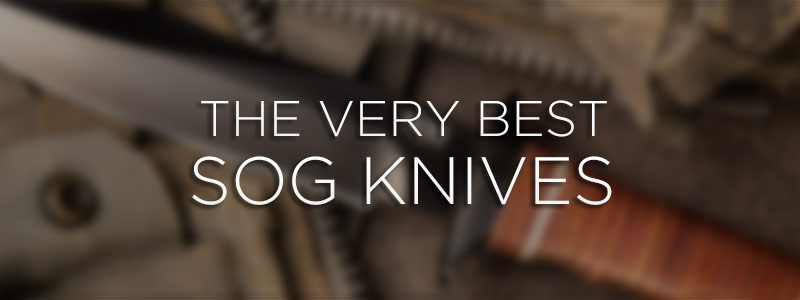
In this article we take a closer look at SOG and pick out some of the best SOG knives on the market today. SOG is a brand in flux right now, working diligently to change the reputation they’ve spent decades acquiring to be a brand that resonates more strongly with enthusiasts and professionals. They’ve traditionally been known for a range of tactical and military style knives as well as a line of creatively engineered multitools, but recent changes at the brand have them branching out into more EDC and Outdoor products as well as bringing some really compelling innovations to market, like the excellent XR Lock as well as their full carbon fiber construction LTE series knives.
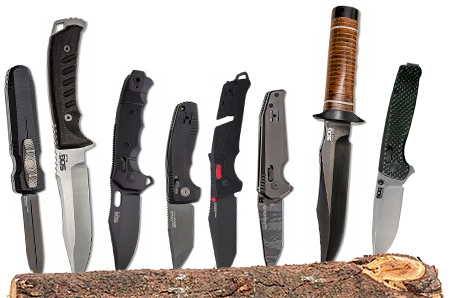
Best SOG Knives: Summary
History
SOG is an acronym, standing for Studies and Observations Group, which dates back prior to the Vietnam War in 1964. MACV-SOG (Military Assistance Command, Vietnam – Studies and Observations Group) was formed as a joint task force comprised of members from Army Special Forces, Navy SEALS, the Air Force, the CIA, and the Marines. SOG operated in Vietnam (as well as Laos and Cambodia) during the war, doing all sorts of special ops things as part of the intelligence operations in the region. They also carried a really freakin’ cool knife with them, known as the SOG Bowie.

The original SOG Bowies were very minimalist tools, 7” long with a stacked leather handle and a clip point blade with a false swedge made from SK-3 steel, usually gun blued to make it less reflective. They came with a leather sheath including a sharpening stone, and the original SOG Bowies were manufactured in Seki City at a cost of $9.85 each. Interestingly, all the SOG Bowies actually used in service were “sterile” – meaning they had no markings on them whatsoever that could trace back to where they came from if they were found.
Those original SOG Bowies inspired a UCLA graduate and industrial designer named Spencer Frazer, who had worked in various industries before he ventured into the world of knives, starting up SOG Specialty Knives & Tools in 1986 to create a replica of the original SOG Bowie. The knives were a success, and soon SOG branched out into more different product lines, including a line of innovative multitools in 1991, and their first compound-leverage multitool in 1996. SOG also continued to adapt new knife designs, creating the Arc-lock in the 90’s (a unique lock that used a pivoting arm and a spring to lock the blade open and closed) and going on to create a series of acclaimed folding knives like the Flash, Aegis, Trident, Twitch, and the Vision (which won the Imported Knife of the Year at Blade Show 1999).
Recommended Models
Below we call out some of our favorite SOG knives and what we like about them.

Right off the top of the list, we have to start with what I think is the best knife SOG makes or has made: the Terminus XR. The Terminus XR is based on the Terminus, which was originally a slipjoint folding knife before it became the first knife in SOG’s lineup to receive the new XR-Lock. We reviewed the Terminus XR a while ago and came away shocked at just how good it was – and it’s only gotten better since then, with a new affordable base model, a steel upgrade on the original model, and a new “GT3 RS” version (actually, called LTE since Porsche would sue) with some high end technology.
But they all share the basic dimensions and excellent handle shape – a 3” flat ground drop point, which if you look up ‘ideal EDC blade profile’ in the dictionary you’d find. Great at piercing, great at slicing, not too long but not too short, the Terminus has the blade shape. The handle is great too, an exercise in simplicity – a good finger scallop and a flat spine, it has enough width to fill the palm but no weirdness. It’s an ergonomic treat.

The basic version comes with G10 handle scales (in a variety of colors, including a trendy natural G10 jade green color as well as deep red, OD green and black) and a stonewashed D2 blade for ~$55 retail. Upgrading to the Carbon Fiber version for $85 brings with it a bump to S35VN steel (the older version we tested used CTS-BDZ1). Both versions are remarkably light at 3.32 ounces, and both use the same XR-Lock. If you’re not familiar, the XR Lock is SOG’s play on the sliding bar lock mechanism which functions similarly to the AXIS lock, using dual springs to propel a horizontal lock bar on top of the blade tang. It also utilizes caged ball bearings for snappy deployment.
Finally, the top line model Terminus XR LTE drops the weight an entire ounce over the regular version, clocking in at 2.35 ounces. This is thanks to the use of carbon fiber liners (!) instead of steel, which is an industry first. The LTE model also gets rid of my one main criticism of the regular XR, which is the terrible pocket clip which is a combination of a billboard as well as a deep top section which gets caught on your pocket. The whole Terminus XR line is EDC perfection at a reasonable price.

On a total different segment, how about a huge fixed blade? The Pillar was a shot over the bow when it debuted at the 2017 SHOT show, a real honest to god high end fixed blade from a brand most people associated with cheap blister-packed knives sold at sporting goods stores. At $190 it’s a pricey thing, but you knew SOG was coming back when the Pillar received a 20/20 score at the notoriously picky everydaycommentary.com, with Tony calling the knife “probably the best production all-around fixed blade available” – high praised indeed.

It’s not a small knife, the Pillar. With a 5” blade and a 9.9” overall length, this is a big knife to take with you camping in the woods, not to cut up a sandwich on your lunch break. The Pillar uses Cryo-treated CPM S35VN steel with a two-tone stonewash finish on the flats and a satin finish on the primary bevel, in a pronounced clip point with a false swedge along the spine. Handles are contoured linen micarta, and the Pillar uses full tang construction for strength. It also includes a kydex sheath with an adjustable low-profile locking mount.
The Pillar is available in four varieties: the two-tone finished blade with the linen micarta handle or a limited edition safety orange G10 handle, a flat dark earth cerakoted blade with greenish micarta, and a blackout version. Made in the USA, too.

We really liked the SOG-TAC XR when we tested it in early 2021 – it was a no BS hard use folding knife with a great lock, reasonable price tag, good action, and a great usable blade shape. Hard to beat for $80, I’d say – and SOG is bringing that energy to the Auto market. The SOG TAC AU line spans three blade sizes and several varieties, but all of them share one thing in common: they’re replacing the old-school plunge (button) lock with the new XR-AU setup, which is a full automatic deployment that uses the XR-Lock as both the switch and the lock as well as the safety mechanism.
Slide the lock forward against a detent and it clicks into the safety position. Pull it back a single click to arm it, or pull it all the way back past the rear detent to fire the blade out – and of course there’s a ‘red means dead’ safety indicator dot on the mechanism to let you know. Compared to the SOG-TAC XR, the AU is actually thinner and lighter, coming it at 0.41” wide versus 0.56”, and 3.5 oz versus 5.23 (for the full-sized 3.5” model.) This is because the AU uses anodized 6061 aluminum handles with a machined texture, versus the XR’s wider G10 over stainless liners, meaning it’s an easier pocket carry as well.
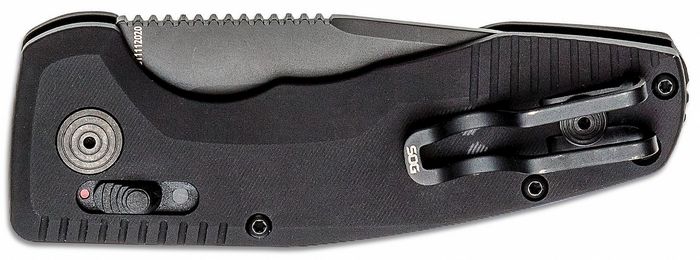
The SOG TAC AU line comes in three different size varieties – the full size with a 3.5” blade and 8” overall, the Compact with a 3” blade and 7” overall, and the CA Special Compact (with the same handle as the Compact, but a stubby 2” blade and 6” overall.) All of them – for the time being – are blacked out with anodized frames and cerakoted blades in Cryo-treated D2 steel, with a choice between drop point and tanto blade shapes as well as partial serrated or plain edge blades. The price point on these is finally giving some much needed competition to the Kershaw Launch line of knives, and if you’re into autos they’re a pretty easy sell.

Pretty lofty price point, the Pentagon OTF, but it’s a bold offering in a market SOG has never even ventured into before – a dual-action out the front (OTF) Auto. It’s got all the hallmarks of a tactical OTF too, like a double-sided dagger grind blade made from cryo treated CPM-S35VN with a cerakote finish (measuring a hefty 3.8 inches), textured and anodized aluminum handles, a stepped deployment/retraction thumb slider, and a deep carry clip. It’s quite tactical-chic.

But the party trick is SOG’s Dynamic Lock-Up System, a unique addition to the regular dual action OTF mechanism. This system promises a wiggle-free blade when open and a rattle-free knife when closed, traditional irritants in OTF’s, as well as being self-adjusting as it wears so it’s lower maintenance than a typical OTF. The system is quite complicated, but the basic gist is that a lateral stop pin drops into place when the blade deploys, wedging the blade over where a dovetailed edge meets a machined groove in the handle that stabilizes it. It’s the kind of next-level thinking conspicuously absent in some other more-expensive US-built OTF’s on the market. You can have one in black or FDE handles, same price, both made in the USA.
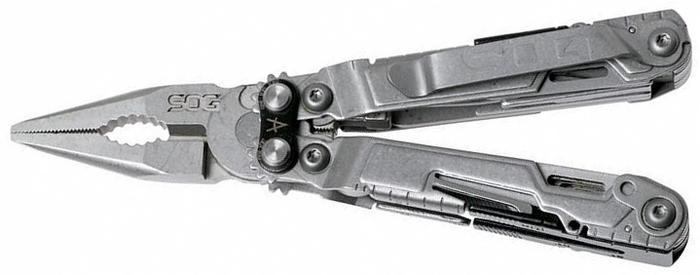
How about a multi-tool? In a market that’s nearly entirely dominated by two brands from Oregon (no points for guessing!) it’s hard to stand apart in the MT market, but SOG has found ways to do so since the 90’s. The Powerpint is one of their most recent models, along with the similar Powerliter (which includes a corkscrew) and its remarkable superpower is tool density. The Powerpint measures in at 5” long and only 4.2 ounces, and somehow manages to pack 18(!) tools in, including a set of pliers with SOG’s gear-driven compound leverage setup. It packs five tool layers per handle side, which is crazy, including plain and serrated blades, scissors, can and bottle openers, several different screwdrivers, a file, an awl, hook cutter, and a bunch more.
It also includes a pocket clip (since it’s small enough to reasonably pocket carry) and it has a magnetic bit holder at the base of the plier head, a clever addition that is basically wasted space on most other multitools.

Another knife for the “that’s not a knife, THIS is a knife!” crowd, the Seal XR is the perfect antidote for anyone that’s still sad Zero Tolerance killed the 0200/0300 series of knives. This bad boy weighs 8.3 ounces. It has a 3.9” long clip point blade made from Cryo CPM-S35VN, measuring a hefty 0.19” thick at the spine. It is of course cerakoted black, the same color as the textured GRN scales. It’s a very heavy duty knife with jimping on seemingly every surface, and a strike pommel on the end of the handle to boot. A wide, hefty bent steel pocket clip provides ambidextrous tip up-carry.

Being an XR lock flipper, it opens on caged ball bearings and provides a variety of opening methods: an oversized flipper tab, an oblong thumb hole, and pulling back on the lock bar and just flicking it out. SOG says the XR lock in the Seal XR can withstand 1,500 pounds of force – a claim I certainly never hope to verify. The handles provide four oversized finger grooves for a confident grip on the knife. If you’re a fan of oversized, overbuilt hard-use folders this is a must-add to your collection. Made in the USA, to boot.

The Trident is part of SOG’s three mainstays – along with the Flash and Aegis. When SOG started on their rebranding, they split their lineup into three categories based on use – Daily, Outdoor, and Professional. The Flash was the anchor of the Daily knife line, the Aegis was the Outdoor, and the Trident is the anchor of the Professional line. It’s designed as a tough-as-nails rescue knife, with features and design to suit the role.
First, the blade: a 3.7” long clip point, the Trident uses Cryo D2 steel with a black cerakote to protect it from corrosion. It’s available as a plain edge or a partially serrated edge as well, and it deploys via assisted opening from a coiled spring around the pivot, locking in place using SOG’s XR lock. There’s a secondary safety switch, a rocker on the spine that prevents the blade from accidentally deploying, with a red indicator dot to show the safety is off.

There’s a lot more to the Trident than just the blade, though: in the closed position, a tungsten carbide glass breaker protrudes from the back of the blade out forward. The cut-out in the handle serves as a seatbelt cutter, drawing material into the narrow channel across the Trident’s blade without the risk of accidentally injuring the victim. And there’s a lanyard hole that’s part of the backspacer, protruding out the rear of the handle. A knife designed from the ground up to make life easier for first responders, and it looks cool to boot.

By the time you read this, it’s probably already gone, but: here is the most technically advanced knife SOG has ever put out. It makes sense, as the original Vision in 1999 was meant to be a technical “look what we can do!” to the rest of the industry, with its innovative (for the time) solid titanium handles. The Vision 35 is a limited edition of only 350 pieces, and when it’s gone it’s gone.
The 35th anniversary version is based on the new Vision XR which recently debuted with the XR Lock (obviously), but the LE version adds several high tech features. The first is that it now sports SOG’s LTE carbon fiber composite liners, to reduce weight over the steel ones. It also uses micro-textured titanium handle scales, along with a deep carry pocket clip set up for ambidextrous tip up carry.
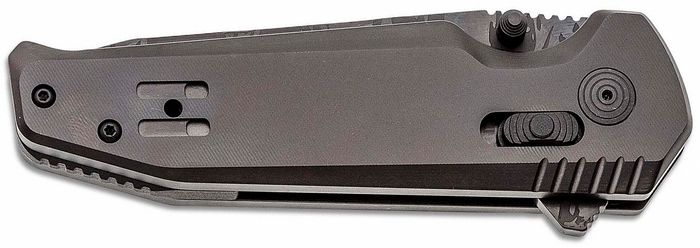
The blade on the Vision 35 is a 3.36” long tanto made from Cryo CTS-XHP tool steel, cerakoted with a unique tiger stripe pattern on it reminiscent of the MACV-SOG Bowies from Vietnam. Each 35th anniversary edition comes with a commemorative coin, in a hard storage case with foam cutouts to keep it secure. Although it’s clearly a collectible item, SOG says the Vision 35 is still made to withstand hard use- thus the sturdy materials and strong lock. And if you don’t like the irreplaceable nature or the high price tag, the standard Vision XR is no slouch either at $149, with the same 3.36” tanto blade in coated CTS-XHP steel, and textured G10 scales over stainless liners.

Finally, we couldn’t make a list of the best SOG knives without mentioning the SOG Bowie, could we? Or, rather, the Super Bowie, which was a redesign of the original that came out in 2006. The Super Bowie retains a lot of elements of the original with some modern touches. It sports a 7.5” hollow ground clip point/bowie blade shape in AUS-8, with a long false swedge on the spine. A double sided cross guard protects your fingers, and it uses an epoxied stacked leather washer handle with a stainless pommel cap for a grip. All of the metal parts are TiNi (Titanium Nitride) coated for protection.

The Super Bowie comes with a leather carry sheath with a belt loop and a snap closure strap for retention. It may not be the ideal everyday carry knife, unless you live in the woods, but it is a cool piece of history.
Competitor Brands
SOG’s brand right now occupies quite a lot of markets, with a broad spread of both types and cost levels of products, from the $400 Vision 35 all the way down to the $9 folding key knife, and occupying every slot from folding knives to fixed blades to one piece and folding multitools. Their products run the gamut from super petite (like the paper-thin Ultra XR) to the huge (like the SOG Super Bowie and the Seal XR.) In terms of the thick of their products, they’re currently focused on what we’d call mid-level knives, meaning $50-$150, with a wide range of very good folding knife options from the bottom of that range (D2 Terminus XR) to the top end (Pentagon XR). This puts them a little below brands like Benchmade and Spyderco price-wise, but more expensive than your typical Kershaw or CRKT.
What sets SOG apart from others in the industry is the rapid redevelopment their lineup is going through at the moment, with nearly all their mainstream knives evolving into higher quality products with better locks and materials than before, no more $30 AUS-8 cheapo folders, and everything we’ve tried so far we’ve liked (with some notes, of course.) They’re pushing the envelope on technology for this market, having developed what I think is a superior alternative to the AXIS lock on their first try at bat.
Wrap Up
If you wrote SOG off years ago as a dead brand pushing outdated products to strip mall knife store enthusiasts, look again: fresh blood and a new direction is pushing the brand towards the top of the mid-level market at alarming speed. Hope you enjoyed our roundup of our favorite SOG knives.





